|
|
Current Status and Prospects of Additive Manufacturing of Flexible Piezoelectric Materials
WEI Xiangxia, ZHANG Xiaofei, XU Kailong, CHEN Zhangwei
2024 Vol. 39 (9): 965–978
 Abstract
Abstract(
299 )
 HTML
HTML(
19)
 PDF
PDF(23227KB)(
446
)
As a kind of important functional material, flexible piezoelectric materials can realize the effective conversion between mechanical energy and electrical energy, with the advantages of good toughness, high plasticity and light weight. Therefore, they can be attached to the human body to obtain human or environment information in real time, which is widely used in the fields of motion detection, health monitoring, and human-computer interaction. Due to high requirements of various three-dimensional (3D) structures of the flexible piezoelectric materials, additive manufacturing has been extensively utilized to fabricate different kinds of piezoelectric materials. This technology is expected to break the bottleneck of traditional processing of piezoelectric material by improving the structural design freedom and the performance of flexible piezoelectric materials, and provides enormous potential and opportunities for the application of flexible piezoelectric materials. Based on the introduction of the classification and features of flexible piezoelectric materials, this paper explained the main additive manufacturing technologies, including fused deposition modeling, direct ink writing, selective laser sintering, electric-assisted direct writing, stereolithography, and inkjet printing that commonly used in processing these materials. Then, various structural designs, such as multi-layer structure, porous structure, and interdigital structure for the flexible piezoelectric materials produced by different additive manufacturing approaches were reviewed. Moreover, the applications of additive manufactured flexible piezoelectric materials in energy harvesting, piezoelectric sensing, human-computer interaction, and bioengineering were introduced. Finally, the challenges faced by additive manufacturing on processing flexible piezoelectric materials and the development trends in the future were summarized and prospected.
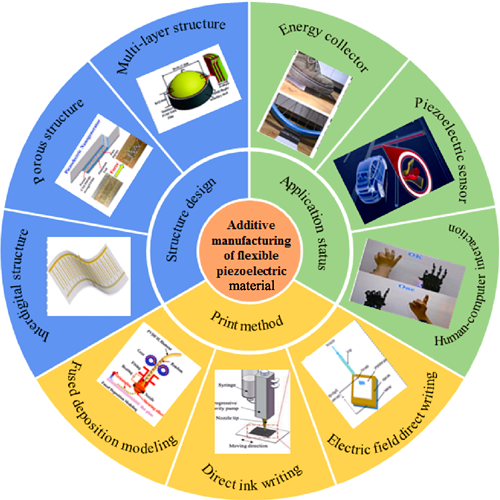
|
|
|
Recent Advances in Electrocatalytic Nitrate Reduction to Ammonia Using Metal Oxides
YANG Xin, HAN Chunqiu, CAO Yuehan, HE Zhen, ZHOU Ying
2024 Vol. 39 (9): 979–991
 Abstract
Abstract(
323 )
 HTML
HTML(
16)
 PDF
PDF(3652KB)(
370
)
Ammonia serves not only as a primary raw material in synthetic fertilizers, but also as a novel high-energy- density fuel. In recent years, electrocatalytic nitrate reduction for ammonia synthesis has gained extensive attention as a green and sustainable approach due to its potential as an eco-friendly and sustainable way that could replace the energy-intensive and high-carbon-emission Haber-Bosch process. Nevertheless, the efficient electrocatalytic ammonia synthesis is still hampered by low reaction efficiency and product selectivity as well as catalyst stability. Hence, there is a pressing need to develop efficient catalysts to advance electrocatalytic nitrate reduction for ammonia synthesis. Recently, metal oxide catalysts have been at the center of attention for their superior performance in electrocatalytic nitrate reduction for ammonia synthesis. This review consolidates the developments of metal oxide electrocatalysts converting nitrate to ammonia, focusing on elucidating the reaction mechanism and introducing typical metal-based (Cu, Fe, Ti, etc.) catalysts. Additionally, it discusses the latest research progress in enhancing catalytic reaction efficiency, product selectivity, and material stability through strategies like morphology control, surface reconstruction, oxygen vacancy engineering, element doping, metal-assisted catalyst loading, etc. Finally, the paper outlines the challenges and future research directions in the realm of electrocatalytic nitrate reduction for ammonia synthesis.
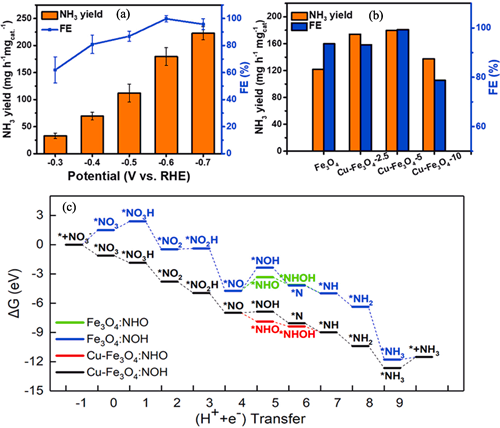
|
|
|
Research Progress on the Application of Silicon Slurry in Lithium-ion Batteries
LIU Pengdong, WANG Zhen, LIU Yongfeng, WEN Guangwu
2024 Vol. 39 (9): 992–1004
 Abstract
Abstract(
212 )
 HTML
HTML(
11)
 PDF
PDF(6937KB)(
256
)
Silicon sludge, the photovoltaic cutting silicon waste, has become one of the expected raw materials for the key silicon carbon anode materials used in high energy density batteries above 300 Wh·kg-1 due to its low cost, two-dimensional lamellar structure and ultrahigh specific capacity (4200 mAh·g-1). However, silicon sludge requires systematic modification because of its challenges such as complex composition, large particle size, poor electrical conductivity, low stability and poor electrochemical performance. This paper systematically reviews the application status and research progress of silicon sludge in lithium-ion batteries. Firstly, the important effects of metal and non-metal impurities on battery performance are summarized, in which metal impurities are normally removed by magnetic separation and acid pickling, and non-metallic impurities are removed by liquid-liquid extraction and heat treatment. Secondly, detailed elucidation about the initial performance and modification methods of the silicon sludge is provided. Concretely, silicon sludge can be nano-sized to reduce expansion by grinding, etching, electrothermal shock, and alloy dealloying, enhance electrical conductivity through doping the intrinsic silicon and doping the carbon layer on the silicon surface, improve stability through the construction of inert layer, conductive layer and functional group, and obtain mechanical support and protection through silicon-carbon composite. Finally, the challenges, development directions and future prospects of silicon-based anode based on silicon sludge are put forward, aiming to provide a reference for converting silicon sludge into treasure and promote the rapid development of high energy density lithium-ion batteries.
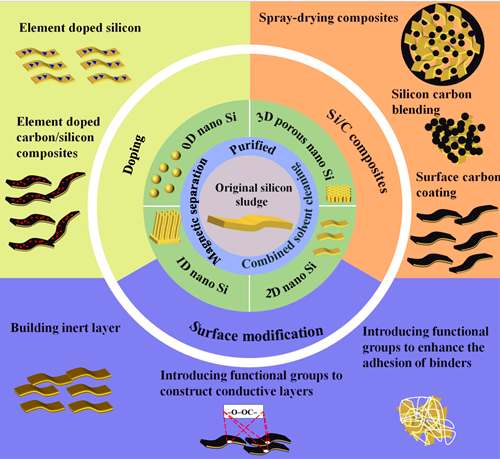
|
|
|
Development of Quasi-solid-state Na-ion Battery Based on Water-minimal Prussian Blue Cathode
WANG Kunpeng, LIU Zhaolin, LIN Cunsheng, WANG Zhiyu
2024 Vol. 39 (9): 1005–1012
 Abstract
Abstract(
184 )
 HTML
HTML(
8)
 PDF
PDF(5268KB)(
222
)
In comparison to Li-ion batteries, Na-ion batteries offer the benefits of low cost, good low-temperature performance, and safety, attracting great attention in the cost- and reliability-sensitive applications. With high capacity and low cost, Prussian blue-like materials (PBAs) stand as promising cathode materials for Na-ion batteries. However, the presence of crystalline water within their structure induces fast performance decay of the battery, serving as a critical bottleneck limiting their application. This work reports a facile thermal treatment strategy to effectively remove crystalline water from PBAs cathode materials, improving capacity retention from 73% to 88% after 340 cycles. The in-situ analysis uncovers that the initial loss of Coulombic efficiency of PBAs cathode is a result of its irreversible transformation from a trigonal form to cubic phase during the charging and discharging process. This issue can be addressed by introducing of Na2C2O4 to compensate the irreversible Na loss in the cathode. On this basis, a high-performance quasi-solid-state Na-ion battery is built by pairing a low-water-content PBAs cathode with Na2C2O4 additive and a hard carbon (HC) anode within a poly(ethylene glycol) diacrylate (PEGDA)-based quasi-solid-state electrolyte with high ionic conductivity and electrochemical stability. This battery exhibits the specific capacities ranging from 58 to 105 mAh·g-1 at current densities from 20 to 500 mA·g-1, capable of sustaining stable cycling for over 200 cycles. This study underscores the significant improvement in stability and capacity of PBAs cathode materials by the efficient removal of crystalline water in them.
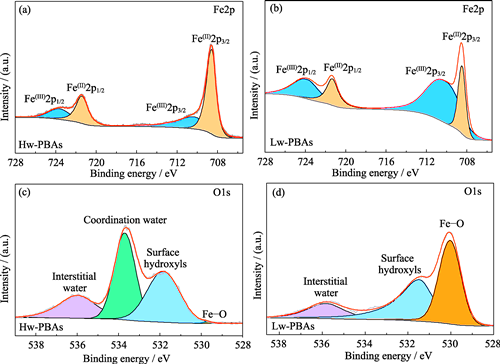
|
|
|
ZIF-L Derived Nitrogen-doped Carbon Nanosheets/Carbon Cloth Self-supported Electrode for Lithium-selenium Battery
XUN Daoxiang, LUO Xuwei, ZHOU Mingran, HE Jiale, RAN Maojin, HU Zhiyi, LI Yu
2024 Vol. 39 (9): 1013–1021
 Abstract
Abstract(
155 )
 HTML
HTML(
6)
 PDF
PDF(2607KB)(
150
)
Selenium (Se) is considered as a new generation energy storage material of lithium-selenium (Li-Se) battery due to its high volume specific capacity (3253 mAh·cm-3) and high electronic conductivity (1×10-5 S·m-1). To address the problems of volume expansion, fast capacity decay, and low utilization of active materials during its charging-discharging process, a ZIF-L derived nitrogen-doped nanosheets/selenium (Se@NC/CC) flexible self-supported composite electrode is designed in this study for lithium-selenium battery by growing two-dimensional zinc-based metallic organic framework (ZIF-L) on carbon cloth (CC). The rich microporous structure in the nitrogen-doped carbon nanosheets can effectively alleviate the volume expansion during the reaction process, and the doping of heteroatoms N helps to adsorb Li2Se and reduce the loss of active substances. In particular, it is found that there is strong chemical bonding between Se and C in the Se@NC/CC electrode, which also helps to reduce the loss of active materials and improve the performance. Electrochemical results show that the initial discharge specific capacity of the Se@NC/CC electrode is 574 mAh·g-1 at a current density of 0.5C (1.0C=675 mAh·g-1), demonstrating a high initial discharge specific capacity. At a current density of 2.0C, the initial discharge specific capacity is 453.3 mAh·g-1, which maintains at 406.2 mAh·g-1 after cycling for 500 cycles and it also displays excellent rate performance compared to literature. Such a flexible self-supported selenium cathode designed in this study provides a new research route on the design of selenium host materials for advanced alkali metal-selenium batteries.
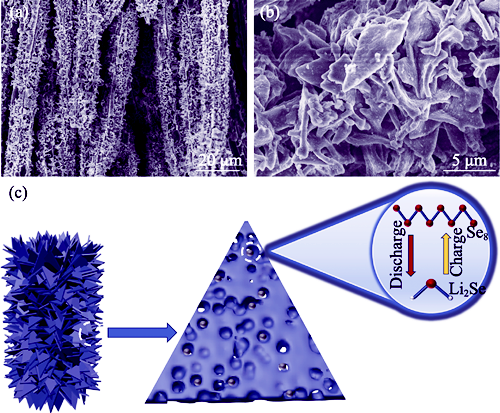
|
|
|
Preparation and Energy Storage Properties of A-site La/Sr Co-doped PbZrO3 Thin Films
SHEN Hao, CHEN Qianqian, ZHOU Boxiang, TANG Xiaodong, ZHANG Yuanyuan
2024 Vol. 39 (9): 1022–1028
 Abstract
Abstract(
134 )
 HTML
HTML(
4)
 PDF
PDF(2089KB)(
150
)
Antiferroelectric materials have been extensively studied in the field of dielectric energy storage due to their ultra-high power density. Lead zirconate (PbZrO3, PZO), as a prototype of antiferroelectric material, has been one of the most studied antiferroelectric materials, and research on enhancing energy storage performance of PZO-based materials is a hotspot of the current study. In this work, further improvement of the energy storage performance of PZO-based antiferroelectric thin films was realized by further doping small-radius Sr2+ into the A-site of the PZO perovskite structure on the basis of La3+-doped PZO. A series of antiferroelectric thin films of A-site La/Sr co-doped Pb0.94-xLa0.04SrxZrO3 (Sr-PLZ-x, x = 0, 0.03, 0.06, 0.09, 0.12) were prepared by Sol-Gel method, and the effects of Sr2+ doping on the crystal structure and electrical properties such as ferroelectricity, energy storage, and fatigue properties of Sr-PLZ-x antiferroelectric films were systematically investigated. The results show that with the doping of Sr2+, the lattice constants are gradually reduced, and the saturation polarization of the films is first slightly increased and then maintained, but finally gradually decreased. The tolerance factors of Sr-PLZ-x films are reduced with increasing Sr2+ doping content, while the antiferroelectricities of the films are enhanced. Both the switching field and the breakdown strength are increased, resulting in an improved energy storage performance of Sr-PLZ-x films. At x=0.03, the energy storage performance of Sr-PLZ-x antiferroelectric film reaches the highest, with the energy storage density and efficiency are 31.7 J/cm3 and 71%, respectively. Meanwhile, the doping of Sr2+ also makes the fatigue characteristics of Sr-PLZ-x antiferroelectric films further improved. The x=0.12 antiferroelectric film exhibits only 3.4% and 2.7% degradation in energy storage density and energy storage efficiency after 107 cycles. In summary, the method of A-site La/Sr co-doping can effectively improve the energy storage performance of PZO-based antiferroelectric films.
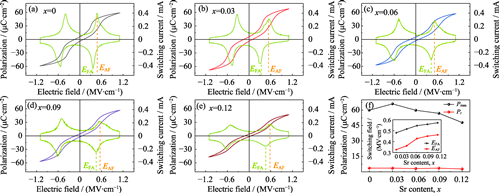
|
|
|
Effect of Doping with Different Concentrations of Y3+ Ions on the Properties of CaF2 Crystals
WANG Xu, LI Xiang, KOU Huamin, FANG Wei, WU Qinghui, SU Liangbi
2024 Vol. 39 (9): 1029–1034
 Abstract
Abstract(
143 )
 HTML
HTML(
5)
 PDF
PDF(566KB)(
220
)
Calcium fluoride (CaF2) crystals have good optical properties and chemical stability, and are often used as substrate materials in extreme edge optical window scenes. It is noteworthy that as one of the key properties of UV laser window materials, the radiation damage resistance of CaF2 crystal increases too fast due to the cleavage effect, and the actual damage threshold is much lower than the theoretical value, which cannot meet the needs of UV high-power laser devices, and is the main factor limiting its application in high-power UV lasers. In this study, material composition design was used to introduce Fi- by doping inert rare earth Y3+, and the cluster effect between Y3+ and Fi- was used to increase the bonding number between the cleavage planes, so as to enhance the interlayer bonding force, reduce the cleavage effect and raise the damage threshold. CaF2 crystals doped with Y3+ were prepared under the same condition by using a porous crucible, and their optical quality, mechanical properties and thermal properties of the doped CaF2 crystals were characterized and analyzed. The experimental results show that appropriate amount of Y3+ doping has little effect on the optical and thermal properties of CaF2 crystals, such as transmittance, thermal expansion coefficient and thermal conductivity, and does not affect the performance of CaF2 crystals. However, the influence on mechanical properties, such as shear strength, is relatively prominent. When the optimized doping concentration is 0.36% (in atom), the shear strength is increased by 68.4%, and the corresponding laser induced damage threshold of Y:CaF2 crystal is increased by 166%.
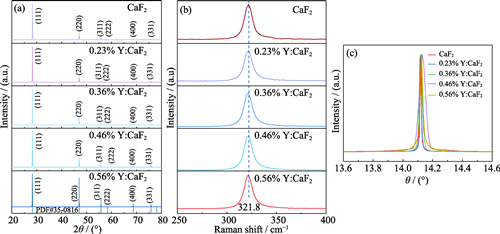
|
|
|
CsPbBr3@MIL-53 Nanocomposite Phosphors: Synthesis, Properties and Applications in White LEDs
QU Mujing, ZHANG Shulan, ZHU Mengmeng, DING Haojie, DUAN Jiaxin, DAI Henglong, ZHOU Guohong, LI Huili
2024 Vol. 39 (9): 1035–1043
 Abstract
Abstract(
110 )
 HTML
HTML(
5)
 PDF
PDF(3088KB)(
203
)
The all-inorganic CsPbX3 (X=Cl, Br, I) perovskite nanocrystals have been widely applied in optoelectronic devices due to their excellent optoelectronic properties. However, their poor stability remains one of the main factors restricting their commercial development. This research focuses on improving the stability and solid-state luminescence performance of CsPbBr3 nanocrystals. The porous MIL-53 (Al) metal-organic frameworks (MOFs) with outstanding hydrophobic properties was chosen as the encapsulation matrix. CsPbBr3 nanocrystals were grown in situ within the MIL-53 (Al) channels by using a thermal injection process to successfully synthesize CsPbBr3@MIL-53 nanocomposite phosphors with outstanding solid-state luminescence performance and high stability. MIL-53 chelates with CsPbBr3 nanocrystals through benzene rings and organic ligands, firmly anchoring nanocrystals in the pores. This not only protects the CsPbBr3 nanocrystals from external environmental influences but also effectively prevents aggregation between nanocrystals, thereby avoiding quenching of solid-state fluorescence. Additionally, the COO- functional groups in MIL-53 bind with the unpaired Pb2+ on the surface of CsPbBr3 nanocrystals, passivating the surface defects and suppressing non-radiative carrier recombination. Furthermore, the contained benzene rings and organic long chains endow the nanocomposite phosphors with excellent hydrophobic properties. The synergistic effect of these factors significantly enhances the optical performance and water stability of CsPbBr3@MIL-53 nanocomposite phosphors. As a result, photoluminescence quantum yield (PLQY) of CsPbBr3@MIL-53 nanocomposite phosphors reaches 75.4%, which is 2.3 times of that of solid-state CsPbBr3 nanocrystal powders (33.2%). Even after being completely immersed in water for 10 h, its fluorescence intensity can still maintain 75.6% of the initial value. Finally, the green-emitting CsPbBr3@MIL-53 nanocomposite phosphors were applied to white LED devices, achieving a wide-color-gamut coverage area of 126% NTSC and 85% Rec. 2020, which demonstrates its application prospects in wide-color-gamut display devices.
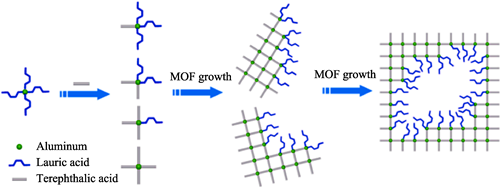
|
|
|
Anti-metastatic Immunotherapy of Advanced Tumors Based on EDTA Intercalated Zinc-aluminum Layered Double Hydroxide
LI Shiqi, BAO Qunqun, HU Ping, SHI Jianlin
2024 Vol. 39 (9): 1044–1052
 Abstract
Abstract(
111 )
 HTML
HTML(
3)
 PDF
PDF(19980KB)(
125
)
Systemic metastasis of cancer cells is currently the main cause of death for patients with advanced cancer. Due to the rapid proliferation of tumor cells and abnormal deposition of extracellular matrix, the large-volume tumor tissue in advanced cancer is dense and stiff, which brings great difficulties to the treatment of advanced solid tumors: conventional drugs having difficulty in penetrating and immune cells facing challenges to infiltrate into their interior. Meanwhile, tumor cells on hard matrices have stronger invasive ability, which is prone to cause systemic metastasis of tumors. To solve this problem, this study prepared ethylenediaminetetraacetic acid (EDTA) intercalated zinc-aluminum layered double hydroxide nanomaterials (EDTA/LDH). Based on two parallel Ca2+ deprivation mechanism, the anti-metastasis immunotherapy of EDTA/LDH material system for advanced large-volume solid tumors was studied. In the slightly acidic tumor microenvironment, the material system adheres to the tumor cell membrane through electrostatic force, releases EDTA to chelate Ca2+ in cell adhesion proteins, cuts off part of the cell connections, reduces the stiffness of large tumors, and promotes the infiltration of immune cells into the tumor tissue. In addition, the material system is phagocytosed by macrophages as a "foreign body", causing calcium store-operated calcium influx, activating the anti-tumor immune effect of macrophages, and inhibiting the tumor-promoting invasion of polymorphonuclear myeloid-derived suppressor cells (PMN-MDSCs) and regulatory T cells (Tregs). This study will provide reference ideas and methods for the anti-metastasis treatment of advanced malignant solid tumors.
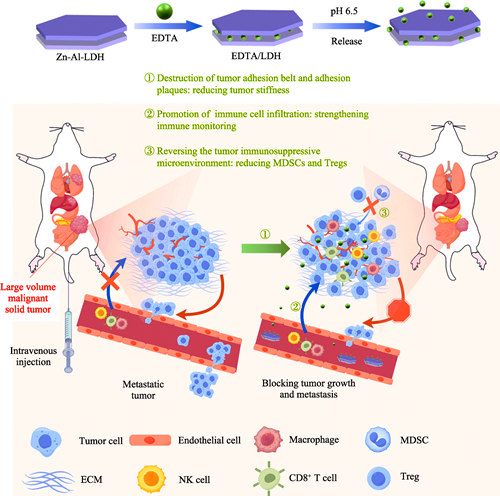
|
|
|
Polyacrylate-calcium (cerium) Nanocluster Fluorescent Probes for Quantitative Detection of Inorganic Phosphorus
CHEN Jia, FAN Yiran, YAN Wenxin, HAN Yingchao
2024 Vol. 39 (9): 1053–1062
 Abstract
Abstract(
109 )
 HTML
HTML(
1)
 PDF
PDF(3559KB)(
92
)
Phosphorus is one of the important elements in the ecosystem and plays a vital role in the process of life cycle. Inorganic phosphorus is a major form of phosphorus, usually in the form of phosphate ions. The rapid and efficient quantitative detection of phosphate ions has always been a hot research direction in the fields of clinical chemistry, pharmacology, biochemical analysis, industrial production and environmental pollution monitoring, but still facing some challenges in accuracy and convenient in some special circumstances. In present work, PAA-Ca(Ce) nanocluster fluorescent probes with good dispersibility and stability were synthesized by complexing with Ca2+ and Ce3+ using polyacrylic acid (PAA) as complexing agent. The reaction product between the probe and the phosphate ion was irradiated by 298 nm excitation light, and a linear graph was established based on the correlation between the peak intensity at the emission peak of 352 nm and the phosphate ion concentration. The experimental results show that the linear relation of the nanofluorescent probe with the (Ca2++Ce3+) concentration of 37.575 mmol/L is y=1.09x+2.05, and the reliability range of fluorescence intensity is 13.5-66.91 mmol/L. Compared with molybdenum-antimony resistance spectrophotometry, this method has a higher recovery. The experimental results of inorganic phosphorus in rat serum verify the reliability of the method. The results above indicate that the fluorescence probe studied in this paper has good quantitative detection performance of phosphate.
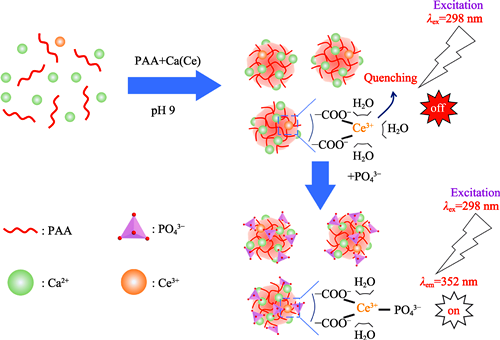
|
|
|
Highly Weak-light Sensitive and Dual-band Switchable Photodetector Based on CuI/Si Unilateral Heterojunction
YANG Jialin, WANG Liangjun, RUAN Siyuan, JIANG Xiulin, YANG Chang
2024 Vol. 39 (9): 1063–1069
 Abstract
Abstract(
132 )
 HTML
HTML(
5)
 PDF
PDF(1960KB)(
119
)
In recent years, copper iodide (CuI) is an emerging p-type wide bandgap semiconductor with high intrinsic Hall mobility, high optical absorption and large exciton binding energy. However, the spectral response and the photoelectric conversion efficiency are limited for CuI-based heterostructure devices, which is related to the difficulty in fabrication of high-quality CuI thin films on other semiconductors. In this study, a p-CuI/n-Si photodiode has been fabricated through a facile solid-phase iodination method. Although the CuI thin film is polycrystalline with obvious structural defects, the CuI/Si diode shows a high weak-light sensitivity and a high rectification ratio of 7.6×104, indicating a good defect tolerance. This is because of the unilateral heterojunction behavior of the formation of the p+n diode. In this work, the mechanism of photocurrent of the p+n diode has been studied comprehensively. Different monochromatic lasers with wavelengths of 400, 505, 635 and 780 nm have been selected for testing the photoresponse. Under zero-bias voltage, the device is a unilateral heterojunction, and only visible light can be absorbed at the Si side. On the other hand, when a bias voltage of -3 V is applied, the photodiode is switched to a broader “UV-visible” band response mode. Therefore, the detection wavelength range can be switched between the “Visible” and “UV-visible” bands by adjusting the bias voltage. Moreover, the obtained CuI/Si diode was very sensitive to weak light illumination. A very high detectivity of 1013-1014 Jones can be achieved with a power density as low as 0.5 μW/cm2, which is significantly higher than that of other Cu-based diodes. These findings underscore the high application potential of CuI when integrated with the traditional Si industry.

|
|
|
Performance of Lateral 4H-SiC Photoconductive Semiconductor Switches by Extrinsic Backside Trigger
WANG Hao, LIU Xuechao, ZHENG Zhong, PAN Xiuhong, XU Jintao, ZHU Xinfeng, CHEN Kun, DENG Weijie, TANG Meibo, GUO Hui, GAO Pan
2024 Vol. 39 (9): 1070–1076
 Abstract
Abstract(
170 )
 HTML
HTML(
3)
 PDF
PDF(3134KB)(
137
)
Photoconductive semiconductor switch (PCSS) can be applied in pulsed high power systems and microwave techniques. However, reducing the damage and increasing the lifetime of silicon carbide (SiC) PCSS are still faced severe challenges. In this study, PCSSs with various structures were prepared on 4-inch diameter, 500 μm thick high-purity semi-insulating 4H-SiC substrates and their on-state resistance and damage mechanisms were investigated. It was found that the PCSS of an Au/TiW/Ni electrode system annealed at 950 ℃ had a minimum on-state resistance of 6.0 Ω at 1 kV bias voltage with a 532 nm and 170 mJ pulsed laser by backside illumination single trigger. The backside illumination single trigger could reduce on-state resistance and alleviate the damage of PCSS compared to the frontside trigger when the diameter of the laser spot was larger than the channel length of PCSS. For the 200 s trigger test by a 10 Hz laser, the black branch-like ablation on Au/TiW/Ni PCSS was mainly caused by thermal stress owing to hot carriers. Replacing metal Ni with boron gallium co-doped zinc oxide (BGZO) thin films annealed at 400 ℃, black branch-like ablation was alleviated while concentric arc damage was obvious at the anode. The major causes of concentric arc are both pulsed laser diffraction and thermal effect.
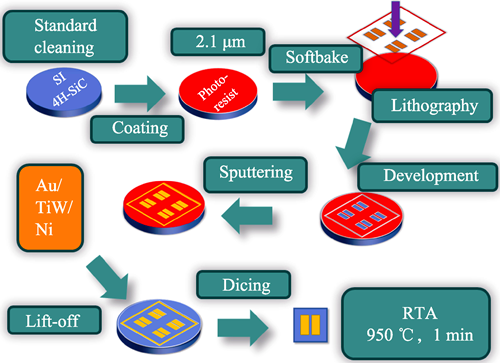
|
|